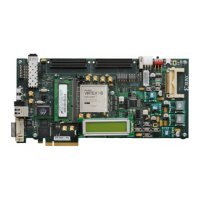Virtex-6 FPGA GTX Transceivers User Guide www.xilinx.com 285
UG366 (v2.5) January 17, 2011
Power Supply and Filtering
There are potentially two major disadvantages to linear regulators: minimum dropout
voltage and limited efficiency. Linear regulators require an input voltage that is higher
than the output voltage. This minimum dropout voltage often depends on the load
current. Even low dropout linear regulators require a minimum difference between the
input voltage and the output voltage of the regulator. The system power supply design
must consider the minimum dropout voltage requirements of the linear regulators.
The efficiency of a linear regulator depends on the voltage difference between the input
and output of the linear regulator. For instance, if the input voltage of the regulator is
2.5 V
DC
and the output voltage of the regulator is 1.2 V
DC
, the voltage difference is
1.3 V
DC
. Assuming that the current into the regulator is essentially equal to the current out
of the regulator, the maximum efficiency of the regulator is 48%. Thus for every watt
delivered to the load, the system must consume an additional watt for regulation. This
power consumed by the regulator generates heat that must be dissipated by the system.
Providing a means to dissipate the heat generated by the linear regulator can drive up the
system cost. So even though from a simple component count and complexity cost the
linear regulator appears to have an advantage over the switching regulator, if the overall
system cost is considered including power consumption and heat dissipation, the linear
regulator can be at a disadvantage in high current applications.
Switching Regulator
A switching regulator can provide a very efficient means to deliver a well-regulated
voltage for the GTX analog power supply. Unlike the linear regulator, the switching
regulator does not depend on the voltage drop between the input voltage of the regulator
and the output voltage to provide regulation. Therefore the switching regulator can supply
large amounts of current to the load while maintaining high power efficiency. It is not
uncommon for a switching regulator to maintain efficiencies of 95% or greater. This
efficiency is not severely impacted by the voltage drop between the input of the regulator
and the output, and it is impacted by the load current in a much lesser degree than the
linear regulator. Because of the efficiency of the switching regulator, the system does not
need to supply as much power to the circuit, and it does not need to provide a means to
dissipate power consumed by the regulator.
The disadvantages to the switching regulator are complexity of the circuit and noise
generated by the regulator switching function. Switching regulator circuits are usually
more complex than linear regulator circuits. This shortcoming in switching regulators has
recently been addressed by several switching regulator component vendors. Normally, a
switching power supply regulation circuit requires a switching transistor element, an
inductor, and a capacitor. Depending on the required efficiency and load requirements, a
switching regulator circuit might require external switching transistors and inductors.
Besides the component count, these switching regulators require very careful placement
and routing on the PCB to be effective.
Switching regulators generate significant noise and therefore usually require additional
filtering before the voltage is delivered to the GTX analog power supply input of the
Virtex-6 FPGA. The amplitude of the noise should be limited to less than 10 mV
PK-PK
.
Therefore the power supply filter should be designed to attenuate the noise from the
switching regulator so that it meets this requirement.

